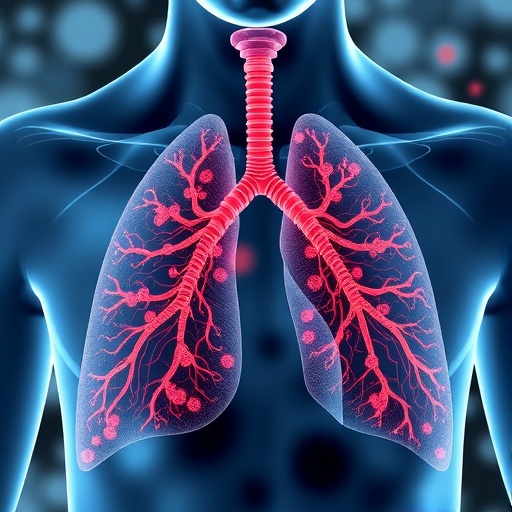Emerging research underscores a significant connection between microRNAs (miRNAs) and epithelial-mesenchymal transition (EMT) in lung cancer, unveiling potential pathways for innovative diagnostics and therapeutic strategies. In lung cancer, the failure of epithelial cells to maintain their properties and the subsequent acquisition of mesenchymal traits represent a pivotal mechanism associated with tumor progression and metastasis. miRNAs, small non-coding RNA molecules that play crucial roles in post-transcriptional regulation, have increasingly been recognized as key modulators of these processes, making them compelling candidates for study in the context of cancer biology.
The phenomenon of EMT is characterized by a series of coordinated molecular changes that enable epithelial cells to lose their junctional integrity and gain migratory and invasive properties. These alterations facilitate the spread of cancer cells beyond their original site, contributing to the aggressive nature of lung tumors. miRNAs appear to regulate a multitude of targets involved in this transition, influencing the expression of various proteins that are critical for maintaining epithelial characteristics and for promoting mesenchymal features. This intricate regulatory network is essential to understanding cancer progression and holds promise for identifying novel biomarkers for diagnostic purposes.
In prior studies, certain miRNAs have been implicated as tumor suppressors, while others function as oncogenes within the context of lung cancer. For example, miR-200 family members are often associated with maintenance of epithelial characteristics and suppression of EMT. Conversely, downregulation of these miRNAs correlates with enhanced invasive potential and metastatic behavior of lung cancer cells. This dichotomy highlights the complexity of miRNA functions, where their expression profiles can dramatically change in response to the tumor microenvironment, thereby tipping the balance between tumor suppression and progression.
Moreover, recent advances have shed light on how specific miRNAs modulate key signaling pathways instrumental in EMT. For instance, the TGF-β signaling pathway, known for its role in promoting EMT, can be influenced by miRNAs that target pivotal mediators within the pathway. Research indicates that miR-21 and miR-155 can enhance TGF-β-mediated effects, fostering a pro-EMT state that enhances tumor aggressiveness. Understanding these relationships not only provides insights into the fundamental biology of lung cancer but also opens doors to potential therapeutic interventions aiming at restoring the balance of miRNA expression.
Given the strong association of miRNAs with EMT, researchers are working to translate these findings into diagnostic tools that could detect lung cancer at earlier stages. The aberrant expression of specific miRNAs in patient samples presents an opportunity for developing non-invasive biomarkers. Liquid biopsies, which analyze circulating blood components, have shown promise in identifying miRNA signatures that correlate with tumor presence and stage. This revolutionary approach could lead to more accurate diagnoses and better monitoring of disease progression, thereby improving patient outcomes.
In addition to diagnostics, the prospect of using miRNAs in therapeutic applications is gaining traction. Several studies are investigating the feasibility of miRNA replacement therapies, where downregulated tumor-suppressive miRNAs are artificially reintroduced into cancer cells. Conversely, strategies that inhibit overexpressed oncogenic miRNAs are also being explored. Understanding the specific context in which these miRNAs function will be crucial for the successful implementation of such therapeutic strategies and for minimizing off-target effects that could arise from indiscriminate miRNA modulation.
The growing body of evidence highlighting the pivotal role of miRNAs in lung cancer underscores the urgency for continued research in this domain. The intricate relationship between miRNAs and EMT in the context of lung cancer is a rich area for exploration, with significant implications for both diagnostic and therapeutic strategies. Researchers are increasingly leveraging advanced techniques such as CRISPR/Cas9 for functional studies of miRNAs, which can elucidate their roles in the dynamics of EMT and tumorigenesis.
Moreover, the potential for miRNA-based therapies is supported by the burgeoning field of gene editing and delivery systems. Nanoparticle-assisted miRNA delivery methods are being refined to enhance the specificity and efficiency of treatment. These innovations not only foster the potential for targeted therapies but also enable the simultaneous delivery of multiple therapeutic agents, amplifying treatment efficacy while mitigating side effects. As researchers continue to bridge the gap between basic science and clinical applications, the translational potential of miRNAs as both biomarkers and therapeutic agents will become more pronounced.
In summary, the exploration of miRNAs within the context of EMT in lung cancer reveals a complex but promising landscape. The interplay between specific miRNAs and signaling pathways that facilitate EMT underscores their critical roles in cancer progression and metastasis. This understanding not only sheds light on the fundamental mechanisms driving lung cancer but also paves the way for innovative approaches to diagnosis and treatment. As the field advances, the integration of miRNA research into clinical practice holds the potential to revolutionize the management of lung cancer, ultimately improving patient prognosis and survival rates.
The impact of the findings presented is profound, as they represent a shift toward more personalized medicine in oncology. By harnessing the unique expression profiles of miRNAs in individual patients, clinicians may soon be able to tailor treatment strategies that are more effective and less harmful. As ongoing research continues to uncover the complexities of these relationships, the future of lung cancer treatment may be redefined through the incorporation of miRNAs as pivotal players in diagnosis and therapy.
Subject of Research: The impact of miRNAs on epithelial–mesenchymal transition in lung cancer and their use as diagnostic markers.
Article Title: The impact of miRNAs on epithelial–mesenchymal transition in lung cancer and the latest advances in their use as diagnostic markers.
Article References:
Shi, Y., Zhao, D., Xiao, Z. et al. The impact of miRNAs on epithelial–mesenchymal transition in lung cancer and the latest advances in their use as diagnostic markers. J Cancer Res Clin Oncol 151, 252 (2025). https://doi.org/10.1007/s00432-025-06298-4
Image Credits: AI Generated
DOI: 10.1007/s00432-025-06298-4
Keywords: miRNAs, epithelial-mesenchymal transition, lung cancer, diagnostics, biomarkers, therapeutic strategies.




